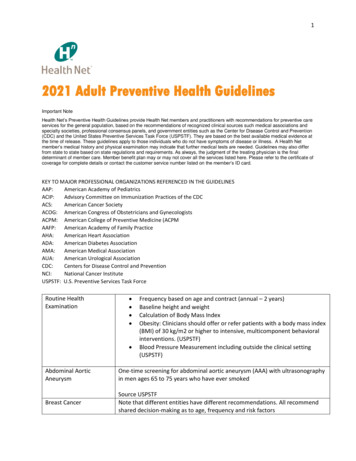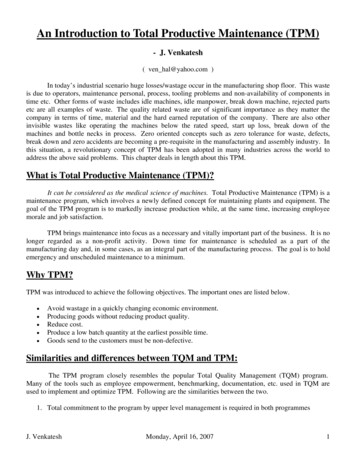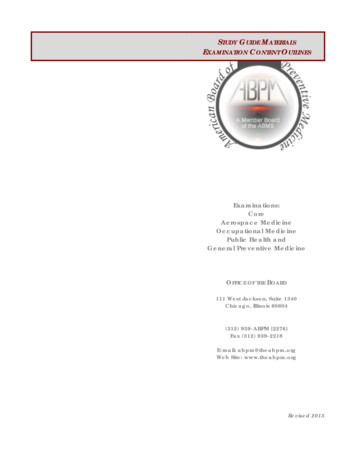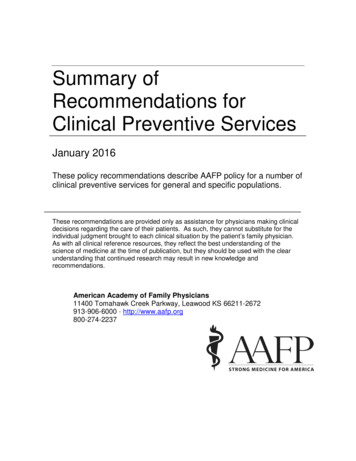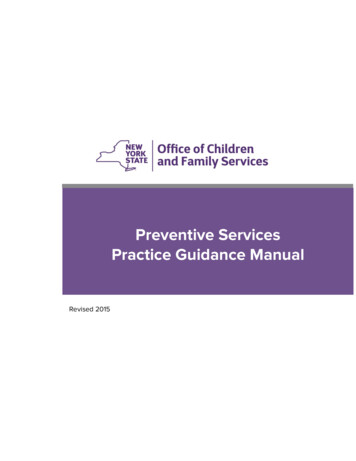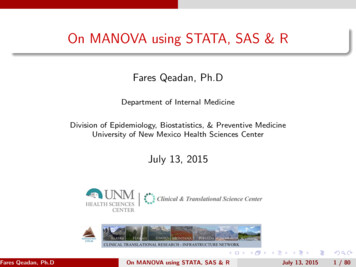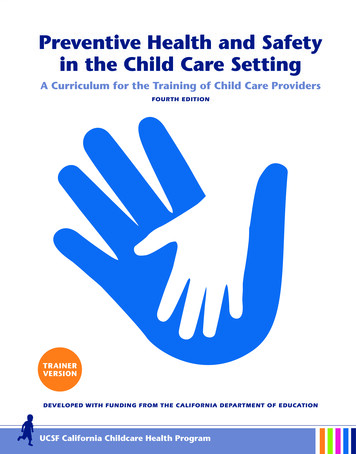
Transcription
Preventive Health and Safetyin the Child Care SettingA Curriculum for the Training of Child Care ProvidersFOURTH EDITIONTRAINERVERSIONDEVELOPED WITH FUNDING FROM THE CALIFORNIA DEPARTMENT OF EDUCATIONUCSF California Childcare Health Program
DEVELOPED BY:University of California, San Francisco (UCSF), School of NursingDepartment of Family Health Care NursingCalifornia Childcare Health Program (CCHP)The California Childcare Health Program is acommunity-oriented, multidisciplinary teamdedicated to enhancing the quality of child carefor California’s children by strengtheninglinkages between the health, safety and childcare communities and the families they serve.Background and AcknowledgementsThis curriculum was first published in June 1998 and updated in 2001, 2018, and 2020. It is meant to beused by a qualified health and safety trainer to meet the preventive health and safety training requirementsto become a licensed child care provider (Health and Safety Code, Section 1596.866) in California. Wewish to acknowledge funding from the California Department of Education and the following people whocontributed their time and expertise to the development of the original curriculum:ContributorsAndrea AzevedoBetty BassoffRobert BatesJudy CalderAdena CohenSara EvingerLucy ChaidezNadja ChristianLyn DaileySandra EdelbrockGail GonzalezDiane HindsRoberta LarsonPamela MurphyPamm ShawMarsha ShermanKaren Sokal-GutierrezElise StoneRick TobinSara WooA. Rahman ZamaniTina ZenzolaCurriculum Revision Team, Fourth EditionBobbie RoseKim HazardMira LiaoJueleah SpencerAbbey AlkonNote:The content of this curriculum is for informational purposes only and does notconstitute medical advice, diagnosis, or treatment. It is not intended to replace a clinicalvisit with a qualified healthcare provider who will complete a medical evaluation, makea diagnosis, and arrive at a treatment plan. You must seek the advice of a qualifiedhealth care provider with any questions you may have regarding your medical condition.2California Childcare Health Program
Preventive Health and Safetyin the Childcare SettingA Curriculum for the Training of Child Care ProvidersFOURTH EDITIONINTRODUCTION: The core content of the Preventive Health and Safety training curriculum (excludingPediatric CPR and First Aid) is arranged into three modules:fetyand Saealth SettingHeivtPreven Child CareChild Care Providersofin theainingulumicA Curre Trfor th FO UR TH ED ITI ONPreventive Health and Safetyin the Childcare SettingA Curriculumfor the Training of ChildcareProvidersh and SafetyPreventive Healt SettingrecaildChethinidersof Childcare Provthe TrainingA Curriculum forNFOUR TH EDITIOFOUR TH EDITIONtiousLE 1f Infection oPrevenMODUUCSFniaCaliforhre HealtChildcaDiseaseogramPrMODULE 2Preventionof InjuriesUCSF California ChildcareHealth ProgramMODULE 3Nutritionh ProgramChildcare HealtUCSF CaliforniaModule 1: Prevention of Infectious DiseaseModule 2: Prevention of InjuriesModule 3: NutritionEach module stands on its own and has its own educational objectives and handouts. The three modulescover the required content of the Emergency Medical Services Authority Child Care 7 Hours Preventive Healthand Safety Training Course and 1 hour of Nutrition training (total of 8 hours) and provide information andguidance on how to control infectious disease in the child care setting, prevent injuries, and provide healthynutrition. Contents of the curriculum and handouts are in agreement with Title 22 regulations. The course isbased on best practice evidence and expert opinion from the Caring for Our Children National Health andSafety Performance Standards Guidance for Early Care and Education Online Data Base, Managing InfectiousDiseases in Child Care and Schools, 5th Edition, the Centers for Disease Control and Prevention, the CaliforniaDepartment of Public Health, the United States Department of Agriculture, and the Environmental ProtectionAgency as of the date of EMSA-approval.The target audience for the training curriculum is child care providers. Trainers with questions onchild health issues in these modules are encouraged to contact the California Childcare Health Program.For technical assistance, call 415-502-2825 or visit cchp.ucsf.edu.Preventive Health and Safety in the Child Care Setting3
Curriculum OverviewInclude Families in Creating a HealthyEnvironmentFamilies are the primary teachers and role modelsfor young children. Families will often say the mostimportant thing they look for when seeking childcare is a healthy and safe environment. With this inmind, child care providers must include families,with cultural awareness and sensitivity, in theirefforts to create healthy environments and promotehealthy habits.The child care providers enrolled in the health andsafety class may be new to the field or experiencedproviders who are taking the course to refresh theirknowledge and assure they are up-to-date. Whatevertheir knowledge level is, encourage participants toengage families in the health and safety messages inthis curriculum.You will find a short time period at the end of eachsection for the instructor to ask the class how andwhen they would communicate the concepts learnedto the families in their programs. This will not onlystimulate students’ understanding of the importanceof communicating with families, but will also assurethat they understand the concepts themselves.Use Developmentally AppropriatePractices when Teaching ChildrenHealthy HabitsDevelopmentally appropriate practices are animportant part of a quality child care program. Childcare providers should keep the ability of the childrenin their care in mind. As children develop differently,the actual age of the child is less important than theability of the child to act and understand conceptsand tasks.Infants and toddlers whose hands must be washedafter diaper-changing may need a differentapproach, depending on how independent theyare. Some 24-month-olds may be able to step upto a sink, turn the water on, and wash their handswith minimal supervision; while others may needto be assisted at each step in the process. Both willprobably want to spend a great deal of time learningfrom their experience with the water.Children respond to a positive and constructivemanner and learn best from consistent, clear, gentleand timely reminders that are pleasant and fun. Forexample, rather than irritably repeating “wash yourhands,” try singing a song about hand washing.TIPS FOR COMMUNICATING WITH FAMILIES Communicate without judgement — do not criticize anyone’s parenting skillsReview all health and safety policies prior to enrollment of a child. The health and safety of theirchildren is a top priority, so this review will reassure the parent that the provider will be working topromote the well-being of the children in their care.Communicate any changes in health and safety policies at family meetings, by written notice inthe primary language of the family (when possible), and informally as you greet the families at thebeginning and end of the day.Communicate new knowledge gained on health and safety issues in newsletters, notes, handouts,emails, posted information, and social media — or any other method you can think of that will reacha particular family group.All of these steps will demonstrate to families that you are working in the best interest of their children.4California Childcare Health Program
Because children love to sing and respond well topositive reminders, your task will be easier, and thechildren will feel good about washing their hands.Incorporating action songs and blending healthpractices into the natural flow of the daily programmakes it easier on everyone. Don’t forget to have fun!Knowledge of the child care context and childcare issues are woven into all content areas of thePreventive Health Training curriculum, includinginformation on child development; up-to-dateinformation on the required Preventive Health topicsin Community Care Regulations 100000.30 b andCalifornia Health and Safety Code Section 1596.866;and information about cultural awareness andcultural sensitivity to address the rich diversity ofchildren and families in California.TARGET AUDIENCE: Child care providersGROUP SIZE: 15 to 20 (ideal). No more than30 students per instructor.Who Can Train?Experienced health and safety trainers, child carehealth consultants and other registered nurses,licensed physicians, or other health care workerswith professional experience in infection control andchild care knowledge may use this curriculum.Materials and EquipmentPresentation slides, laptop, and LCD projector VCR and monitor (if needed for showing VHSvideo) Copies of student handouts Flip chart/chalkboard/whiteboard Materials for demonstrations and group activities Length of TrainingTitle 22 California child care regulations require16 hours of health and safety training to becomelicensed: eight hours for CPR and First Aid (notincluded in this class); seven hours for preventionof infectious disease and prevention of injuries; andone hour of child care nutrition. This curriculumis designed to assist the trainer in meeting thelicensing requirements, best practices, and providingsufficient information and resources for eight hoursof prevention of infectious disease (four hours),prevention of injuries (three hours), and child carenutrition (one hour).Class Completion Cardsand Emergency Medical ServicesAuthority (EMSA) StickersTo become licensed, participants must earn a classcompletion card with a valid EMSA sticker attachedas proof of successfully completing eight hoursof Preventive Health training. For access to classcompletion cards and EMSA stickers, trainers arerequired to use an EMSA approved curriculum thatcovers the required topics.ReferencePreventive Health and Safety in the Child CareSetting, A Curriculum for the Training of Child CareProviders, Fourth Edition, Developed by the UCSFCalifornia Childcare Health Program with fundingfrom the California Department of Education.Preventive Health and Safety in the Child Care Setting5
CURRICULUM LEARNING OBJECTIVESModule 1: Four-hour course content includes:Section 1: Understanding the Spread of Disease Section 2: Preventing the Spread of Infectious Disease Section 3: Policies to Prevent the Spread of Infectious Disease Section 4: Information on Specific Diseases By the end of this module, participants will:Be aware of the ways illnesses spread in the child care setting. Understand how to reduce the spread of illness. Understand how to follow standard precautions and other key preventive health practices. Understand how to establish, communicate, and promote written policies regarding health and safety inchild care programs. Be familiar with local health and safety resources for child care providers and families. Understand how to protect child care staff from exposure to infectious diseases including HIV/AIDS, CMV,and hepatitis B and C. Module 2: Three-hour course content includes:Section 1: Understanding Childhood Injuries Section 2: Preventing Childhood Injuries Section 3: Safety Policies and Routines By the end of this module, participants will:Understand how child development influences the risk of injury. Be aware of conditions in which common childhood injuries occur. Understand how safety practices and routines reduce the risk of children’s injuries. Understand how to establish, communicate, and promote written policies for and safety in child care programs. Be familiar with tools and resources to keep child care programs safe for children. Understand practices to reduce the risk of injuries for child care staff. Module 3: One-hour course content includes:Understanding Why Child Nutrition Is ImportantServing Healthy Food and Drinks to Children in Child Care Programs Nutrition Policies and the Child and Adult Care Food Program (CACFP) By the end of this module, participants will:Understand why nutrition is important for children’s health. Understand the basics of nutrition for growing children according to current Dietary Guidelines forAmericans. Have access to CACFP information and resources and contact information to participate in CACFP. Understand how to establish, communicate, and promote written policies for healthy eating and drinking inchild care programs. Be familiar with food safety principles, choking prevention, and caring for children with special dietary needs. Appendix: Additional Resources6California Childcare Health Program
Preventive Health and Safetyin the Child Care SettingA Curriculum for the Training of Child Care ProvidersFOURTH EDITIONMODULE 1Prevention of Infectious DiseaseUCSF California Childcare Health ProgramFEB 2020
MODULE 1Prevention of Infectious DiseaseMODULE CONTENTS:1.4SECTION 1: Understanding the Spread of Disease1.5What Is a Communicable Disease?1.6How to Prevent the Spread of Illness1.10SECTION 2: Preventing the Spread of Infectious Disease1.12The Daily Morning Health Check1.14Standard Precautions1.17Hand Washing1.21Use of Disposable Gloves1.23Cleaning, Sanitizing, and Disinfecting1.27Disposal of Garbage1.27Diapering/Toileting1.31Food Safety1.36Oral Health1.39Open Space and Indoor Air Quality1.42Water Supply1.45Pets, Pests, Pesticides, and Integrated Pest Management (IPM)1.50Sandboxes and Sand Play Areas1.52SECTION 3: Policies to Prevent the Spread of Infectious Disease1.54Health and Safety Policies1.61Health History and Emergency Information Policy1.62Immunization Requirements and Policy1.69Keeping Health Records1.72Excluding Children Due to Illness1.85Staff Health Policies1.88Communicating about Illness in Child Care1.90Caring for Children with Mild Illness1.92Medication Administration Policy1.99Children with Special Needs1.105Emergency Illness and Injury Procedures1.106No Smoking or Use of Alcohol or Illegal Drugs1.1071.2SECTION 4: Information on Specific DiseasesCalifornia Childcare Health Program
ESTIMATED TRAINING TIME BY MODULE TOPICTIME(Minutes)SECTIONSTOPICS1. Understanding theSpread of DiseaseWhat Is a Communicable Disease?5How To Prevent the Spread of Illness152. Preventing theSpread of InfectiousDiseaseThe Daily Morning Health Check5Standard Precautions5Hand Washing10Use of Disposable Gloves3. Policies to Preventthe Spread of InfectiousDisease5Cleaning, Sanitizing, and Disinfecting10Disposal of Garbage10Diapering/Toileting10Food Safety10Oral Health10Open Space and Indoor Air Quality5Water Supply15Pets/Pests/Integrated Pest Management (IPM)10Sandboxes and Play Areas5Health and Safety Policies5Health History and Emergency Information Policy5Immunization Requirements and Policy15Keeping Health Records5Excluding Children Due to Illness10Staff Health Policies5Communicating about Illness in Child Care10Caring for Children with Mild Illness10Medication Administration Policy15Children with Special Needs10Emergency Illness and Injury Procedures10No Smoking or Use of Alcohol or Illegal drugs10Total Training Time Recommended for Module 1: 4 hoursTraining Tip: Remember to plan for breaks to stretch, drink water, and use the restroom.Prevention of Infectious Disease1.3
MODULE 1 / SECTION 1Understanding the Spreadof DiseaseTRAINER GUIDESECTIONTOPICS What Is a CommunicableDisease?How to Prevent theSpread of IllnessRationale: Illnesses are common among young children, and thosein the child care setting are at higher risk of getting sick. This riskcan be reduced through creating a healthy environment and healthypractices.Time: 20 minutesLearning ObjectivesParticipants will:1. Understand what a communicable disease is2. Know why children in child care settings have more infectiousdiseases3. Identify four major ways infectious diseases are spread4. Know how to reduce the spread of common childhood illnessesTeaching Methods/Suggested ActivitiesIcebreaking: Ask providers to introduce themselves and say whatdiseases they expect to see in the child care setting. Lecture: Review the ways that diseases are spread in the child caresetting. Review the practices and procedures that help to reduce thespread of common illnesses. Questions/Answers: Respond to any questions that the groupmay have, and ask questions and emphasize important points thathighlight the important concepts. Materials and Equipment RequiredStudent Handouts Flip Chart/Chalkboard/Whiteboard Presentation Slides (if using a computer and LCD projector) Supplies and equipment for hands-on and group activities Questions/CommentsAsk participants to identify factors (places, people, and conditions) intheir child care setting that increase the risk of disease. Ask providers to describe practices and procedures that reduce thespread of illnesses in the child care setting. Ask the class how they would communicate the concepts learned tothe families. 1.4California Childcare Health Program
What Is a Communicable Disease?Infants and young children in child care havean increased rate of certain infectious diseases.Prevention of infectious disease in the child caresetting will help families and child care providersimprove their quality of life and save time, healthcare costs, and lost work.Why Do Children in Child CareSettings Have More Illnesses?Illnesses caused by infection with specific germssuch as viruses, bacteria, funguses, and parasitesare called infectious diseases. Communicablediseases are those illnesses that can be spread fromone person to another either directly or indirectly.Infectious diseases that commonly occur amongchildren are often communicable and may spreadvery easily from person to person. The word“contagious” is also used to describe communicabledisease. Anyone at any age can be infected withcommunicable illnesses, but young children are atgreater risk because:They have not yet been exposed to many of themost common germs. Therefore, they have not yetbuilt up resistance or immunity to them. They also have many habits that promote thespread of germs. For example, they play on thefloor and often put their fingers, toys, and otherobjects in their mouths. In this way, germs enterand leave the body can be passed on to others. They have close contact with other childrenand adults.Most illnesses are contagious before their signs andsymptoms appear. Some people may pass the germswithout having the symptoms or continue passingthem even after the symptoms of illness are gone.Prevention of Infectious Disease1.5
How to Prevent the Spread of IllnessHow Are Illnesses Spread?Communicable diseases are spread from the sourceof infection to the exposed, vulnerable person (host).For this transmission to happen, three things arenecessary.1. Source of germs must be present.2. Route or (ways) of transmission along whichgerms can be carried must be present.3. A host or vulnerable person who is not immune tothe germ must be present and come in contact withthe germs.What Can You Do to Keep the Childrenand Adults in Your Program Healthy?Break the chain of transmission by breaking at leastone of the three links. For best results, use morethan one method of control in order to reduce thetransmission of infectious disease.You can control the spread of communicable diseasein three ways:At the source of infection or the “first link” byidentification, treatment and, if necessary, isolationof the sick person. In the child care setting this isaccomplished by doing a morning health check/observation, and if necessary excluding ill children,referring them for medical care, and notifying healthauthorities when required.At the route of transmission or the “secondlink” by personal hygiene; proper cleaning,sanitizing, and disinfecting of objects and surfaces;using proper diapering techniques; proper handwashing; and ventilation.By protecting the vulnerable person or the“third link” through immunization and healthyhabits, for example: hand washing, good nutrition,exercise, and getting enough sleep.1.6California Childcare Health ProgramFour Major Ways for the Spread ofIllnesses or “Routes of Transmission”1. Through direct contact with peopleor objects:Infections can spread by direct contact with an infectedarea of someone’s body (for example, an open sore) orby contact with a surface that has infectious materialon it. Bacteria, viruses, fungi, or parasites causeillnesses. Because young children are constantlytouching their surroundings and the people aroundthem, infections can spread easily among childrenand their caregivers in the child care setting.2. Through the air or “respiratorytransmission” (passing from the lungs,throat, or nose of one person to anotherperson through the air):Respiratory illnesses are spread through microscopic,contagious droplets of fluids from the nose, eyes, orthroat. When an infected person talks, sings, coughs,sneezes, or blows their nose, infectious dropletsget into the air where they can be breathed in byanother person. Droplets can also land on handsor objects such as toys or food, and can be touched,mouthed, or eaten by other persons. When the germsin these infected droplets come in contact with thenose, eyes, or mouth of an uninfected person, theycan multiply and cause illness.3. Through stool or “fecal-oral” transmission(transfer of a germ from an infected person’sstool into another person’s mouth):Some diseases are spread through exposure togerms in the stool (feces, bowel movement) or bywhat is known as the fecal-oral route. This meansthat germs leave the body of the infected personin their stool and enter the body of another personthrough their mouth.
In most situations this happens when hands orobjects have become contaminated with a verysmall amount of stool (usually too small to be seen)are placed in the mouth. Or when food or water iscontaminated with a very small amount of human oranimal stool and then is eaten or drunk. Improperlyprepared foods made from animals (for example,meat, milk, and eggs) can be the source of infection.Some infections, such as salmonella, may be spreadthrough direct exposure to infected animals.4. Through contact with blood andbody fluids:Some infections are spread when blood from aperson with an infection gets into the bloodstream ofan uninfected person. Hepatitis B and C, and HIV/AIDS are serious viral infections spread by contactwith infected blood. Cyctomegalovirus (CMV) isan example of a disease spread by urine or saliva.These viruses can be spread when blood or bodyfluids containing the virus enters the blood stream ofanother person. Spread can also occur when infectedblood or body fluids come in contact with skin thathas open sores, is damaged by conditions such aseczema, or with a broken surface of the mucousmembranes (such as the inside lining of the mouth,eyes, nose, rectum or genitals). An infected mothercan also transmit these infections to her newborninfant. Once these viruses enter a person’s body,they may stay for months or years. This person mayappear to be healthy but can still spread the viruses.How to Reduce the Spread of Illnessesthrough Direct ContactMake sure staff and children wash their handsafter contact with any body fluids. Wear disposable gloves when touching bodyfluids (including feces) or objects and surfacescontaminated with body fluids. Use running water for hand washing. Do notuse basins or stoppered sinks, which can becomecontaminated with the germs. Use plain liquid soap and single-use disposablepaper towels or single-use cloth towels. Always use single-use disposable tissues forwiping noses. Never use the same tissue for morethan one child. Dispose of used tissues, wipes, and paper towels ina lined, covered, trash container with a foot pedalkept away from food and supplies. Follow recommended procedures for cleaning,sanitizing, and disinfecting toys and surfaces. Follow recommended procedures for diapering. Make sure that each child has their own cribor nap mat, sheets, pillow cases, and blankets. Do not allow children to share personal itemssuch as combs, brushes, blankets, pillows, hats,or clothing. Store each child’s dirty clothing separately inplastic bags and send it home for laundering. Wash and cover sores, boils, blisters, cuts, orscrapes promptly and wipe away eye discharge. Report rashes, sores, eye discharge, and severeitching to the family so they can contact theirhealth care provider(s). How to Reduce the Spread ofRespiratory IllnessesProvide ventilation. Air out the facility daily, evenin winter. Encourage outdoor play. Teach children and staff to cough or sneeze intotheir elbow or sleeve. If they sneeze or cough intoa hand or tissue, they must properly dispose of thetissue and wash their hands. Ensure that staff and children wash their handsafter wiping or blowing noses; after contact withany fluids from nose, throat, or eye; and beforepreparing or eating food. Don’t allow food or eating utensils to be shared. Clean and sanitize mouthed toys. Clean eating utensils carefully in soapy water;then rinse, sanitize, and air dry (known as thethree sink method) or use a dishwasher to sanitizedishes and utensils. Use single-use disposable cups, or reusable cupsthat are cleaned and sanitized after each use. Wipe runny noses and eyes promptly, and washhands afterwards. Use single-use disposable towels/tissues. Dispose of towels/tissues contaminated withfluids from nose, throat, or eye in a coveredcontainer with a plastic liner away from foodand supplies. Don’t kiss children on the lips; instead givechildren hugs. Prevention of Infectious Disease1.7
How to Reduce the Spread ofInfections through StoolSince children and staff who have digestive illnessesdon’t always feel sick or have diarrhea, the bestmethod for preventing the spread of these diseasesis to have standard precautions in place at yourprogram. Many germs can survive on surfaces forperiods ranging from hours to weeks.PRACTICE THE FOLLOWING:Strict enforcement of hand washing for adultsand children. Environmental cleaning, sanitizing, anddisinfecting with focus on diapering, toileting,and food preparation areas. Exclusion guidelines: Excluded children andstaff may come back after treatment and whenthe diarrhea improves such that stool doesn’tleak from the diaper and/or there are no toiletingaccidents. With some diarrheal illnesses, approvalof the child’s health provider is needed. How to Reduce the Spread of Diseasesthrough Contact with Blood andOther Bodily FluidsTreat blood and other body fluids as if they werecontagious. Wear protective gloves when handlingblood, urine, and saliva.Transmission of illnesses spread through bloodis very rare in the child care setting, and illnessessuch as HIV/AIDS are not spread by casual,daily contact with infected persons. However,HIV can be transmitted where there is blood contact.For example: ouching blood while giving first aid with handsTor body surfaces that have cuts or open sores Collision accidents where the skin of both people isbroken and blood is exchanged 1.8California Childcare Health Program leaning up blood after an accident with handsCthat have cuts or open sores Biting. The only way blood-to-blood exchange canhappen through biting is for the following eventsto occur: There is an injury to the mouth of the biter. The bite creates a wound so serious that the skinis broken and blood flows. Blood is exchanged. One of the children involved is infected with HIV. STANDARD PRECAUTIONS:The infection control practices listed below shouldbe followed for all children, whether or not they areinfected with blood borne illnesses.Proper hand washing Proper use of gloves Proper disposal of waste and contaminatedmaterials such as gloves, paper towels, andbandages Proper cleaning, sanitizing, and disinfection. Proper care of soiled clothing Immunization for all children and staff againstHepatitis B Teaching all children not to touch any blood excepttheir own
EXAMPLES:How Some Childhood Infectious Diseases Are SpreadTransmissionAir orRespiratoryStool orFecal-OralDirectContactContact withBlood andBodily FluidsHow the diseaseis spreadBreathing germsin the air Contact withinfected salivaand mucus Mouth contactwith itemsand handscontaminated byinfected stoolContact withinfected hair,skin and objectsContact withinfected bloodand sometimesother bodyfluidsBehaviors thatspreadExamples ofdiseasesCoughing or sneezinginto the air Kissing on the mouth Sharing mouthed toys Wiping noses withoutthorough hand washing Poor ventilation Diapering and toileting orfood preparation withoutthorough hand washing Sharing mouthed toys Unsafe food preparation Unsafe diaperingprocedures Touching skin or hairwhich is infected Sharing clothing, hatsand brushes which areinfectedSalmonella Shigella Giardia Pinworms Sexual contact Changing bloody diaperswithout gloves Providing first aidwithout gloves Getting infected blood orbody fluids into brokenskin, eyes or mouthCoughing Fever Rash Runny nose Sore throat Stomach ache Nausea Vomiting Diarrhea Hand, foot andmouth disease Hepatitis A Polio E. coli Noro virus HerpesRingworm Scabies Head lice Impetigo Chickenpox Cold Flu Measles Tuberculosis(TB) Chickenpox PossiblesymptomsRashOozing sores Itching Visible nits oreggs HIV/AIDS Hepatitis B & C Cytomegalovirus(CMV) Herpes Fatigue Weight loss Yellow skin Weakenedimmunesystem Sores Fever Swollenlymph nodes Prevention of Infectious Disease1.9
MODULE 1 / SECTION 2Preventing the Spread ofInfectious DiseaseTRAINER GUIDESECTIONTOPICS The Daily MorningHealth CheckRationale: Intentional practices can prevent the spread of diseases andreduce the risk of illness among children and adults in child care settings.Time: 1 hour, 50 minutesLearning Objectives Standard Precautions Hand Washing When to Wash Hands Use of Disposable Gloves2. Describe what is mean
health care provider with any questions you may have regarding your medical condition. . Diseases in Child Care and Schools, 5th Edition, the Centers for Disease Control and Prevention, the California . one hour of child care nutrition. This cu
